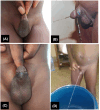Characteristics and management of post-circumcision Urethrocutaneous Fistula: a retrospective study in surgical units in Cameroon
- PMID: 39022657
- PMCID: PMC11250727
- DOI: 10.1002/bco2.391
Characteristics and management of post-circumcision Urethrocutaneous Fistula: a retrospective study in surgical units in Cameroon
Erratum in
-
Erratum.BJUI Compass. 2024 Dec 30;5(12):1324-1329. doi: 10.1002/bco2.482. eCollection 2024 Dec. BJUI Compass. 2024. PMID: 39744071 Free PMC article.
Abstract
Background: Urethrocutaneous fistula (UCF) is one of the major complications of circumcision. The risk factors associated with UCF are not clear-cut but its repair remains a challenge for urological surgeons. The aim of this study was to highlight the epidemiological, and clinical features and outcomes obtained from the management of UCF in the context of a country with limited medical resources where ritual circumcision is widely practiced.
Patients and methods: From February 2010 to December 2022, 35 patients underwent surgical repair for post-circumcision UCF in two tertiary hospitals in Yaounde, Cameroon. Simple closure, Thiersch-Duplay-Snodgrass and Mathieu techniques were performed.
Results: The mean age of patients was 7.4 ± 4.1 years with a range of 2 to 21 years; the median age at circumcision was 24 months (12; 48). Most (95%) of circumcisions were performed by paramedical staff. The majority of patients (n = 26) consulted for a bifid stream, Three-quarters of fistulae were located at the corona. Small fistulae represented 74.28% (n = 26) of cases as opposed to large fistulae (25.71%). More than 70% of patients underwent a simple closure. The therapeutic results were satisfactory in 91.4% of cases (n = 32) after an average follow-up of 91.85 ± 51.92 months. There were no statistically significant differences between the patients with coronal fistula and patients with distal penile fistula concerning demographic, clinical and surgical characteristics.
Conclusion: Urethrocutaneous fistula is a major and frequent complication of circumcision mostly practiced by non-qualified personnel on children aged 24 months. The usual presentation is micturition with a bifid stream occurring on average 3 months after circumcision. Coronal fistulas are the commoner location. Simple closure, Thiersch-Duplay-Snodgrass and Mathieu technique appear to be safe with the advantages of low recurrence rate. An accurate diagnosis with a timeframe respecting the principles of fistula surgery combined with regular follow-up is mandatory for good long-term results with a low recurrence rate. Further prospective studies on the factors affecting the formation of urethrocutaneous fistula should be performed to prevent this complication of circumcision.
Keywords: Cameroon; characteristics; outcomes; post‐circumcision; surgical repair; urethrocutaneous fistula.
© 2024 The Author(s). BJUI Compass published by John Wiley & Sons Ltd on behalf of BJU International Company.
Conflict of interest statement
The authors declare that they have no competing interests.
Figures




References
-
- Weiss H, Polonsky J. Male circumcision Male circumcision: global trends and determinants of prevalence, safety and acceptability Geneva: World Health Organization; 2007.
-
- Mouafo TFF, Ditope JJ, Fossi G, Fadi S, Nyanit BD, Mbouche L, et al. Anatomic, clinical and therapeutic aspects of circumcision accidents in Yaounde, Cameroon. Int Arch Urol Complic. 2016;2(1):1–3.
LinkOut - more resources
Full Text Sources
